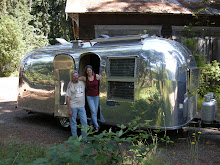 Unfortunately, in the case of the Mountain Pine Beetle, the worst is yet to come. Those trees that cannot be harvested, and there will be millions of them, may continue to stand for 15-20 years. Eventually wind will knock them down and the fuel will pile up. Finally, when something like a lightning strike triggers a fire, there will be so much fuel that the scope of these fires could be staggering. In western British Columbia alone, there are over 30 million acres of dead trees. And in the U.S. the number of affected acres is growing at an astonishing rate. What I did not know, and what shocked me even further, is that in most cases the mortality rate in these affected forests will approach 100%. That means that in many areas, every living pine tree as far as the eye can see will be dead. This will not only have a huge effect on the environment; it will completely change the look of those areas and the lives of the wildlife and people that live there.
Unfortunately, in the case of the Mountain Pine Beetle, the worst is yet to come. Those trees that cannot be harvested, and there will be millions of them, may continue to stand for 15-20 years. Eventually wind will knock them down and the fuel will pile up. Finally, when something like a lightning strike triggers a fire, there will be so much fuel that the scope of these fires could be staggering. In western British Columbia alone, there are over 30 million acres of dead trees. And in the U.S. the number of affected acres is growing at an astonishing rate. What I did not know, and what shocked me even further, is that in most cases the mortality rate in these affected forests will approach 100%. That means that in many areas, every living pine tree as far as the eye can see will be dead. This will not only have a huge effect on the environment; it will completely change the look of those areas and the lives of the wildlife and people that live there.Right now the standing forests of red trees and the pockets of affected but not yet dead green trees, still creates the illusion of a forest. At some point however, the illusion will fail and we will be left with a landscape bereft of pine trees.
There are other severe consequences of this. These forests are sequestering massive amounts of CO2, both on an active and passive level. Once they die, they will no longer be doing this job. Indeed their carcasses will begin to give up all the CO2 they have been quietly holding for many, many years. At a time when we need all the carbon sinks we have, many of these dead trees will become CO2 emitters.
I asked Andy point blank if the any of the forest management practices used by the Forest Service were responsible for the current situation. He thought for a moment and gave us an answer that basically said “no”, but with the caveat that we also just don’t know. If anything he felt that some of the practices such as thinning and prescribed burns may have helped lessen the impact. I am not so sure. I see an eco-system that is stressed. And that stress may just be some of the first really visible signs of the coming disaster that is global warming. But admittedly, I don’t know, they don’t know, nobody knows. But something is terribly wrong in these forests.
Next-Where do we go from here?




No comments:
Post a Comment